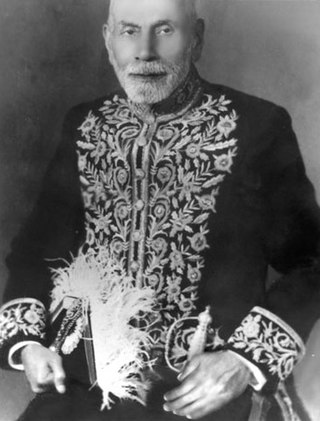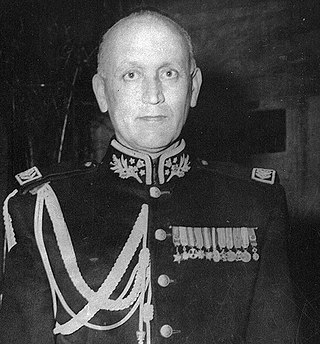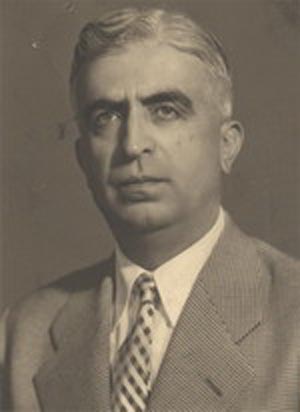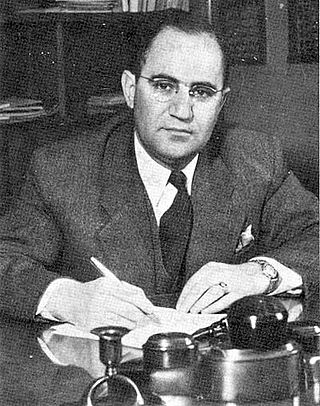| |||||
| Decades: | |||||
|---|---|---|---|---|---|
| See also: | Other events of 1952 Years in Iran | ||||
Events from the year 1953 in Iran.
| |||||
| Decades: | |||||
|---|---|---|---|---|---|
| See also: | Other events of 1952 Years in Iran | ||||
Events from the year 1953 in Iran.

Mohammad Mosaddegh was an Iranian politician, author, and lawyer who served as the 30th Prime Minister of Iran from 1951 to 1953, elected by the 16th Majlis. He was a member of the Iranian parliament from 1923, and served through a contentious 1952 election into the 17th Iranian Majlis, until his government was overthrown in the 1953 Iran coup aided by the intelligence agencies of the United Kingdom (MI6) and the United States (CIA), led by Kermit Roosevelt Jr. His National Front was suppressed from the 1954 election.

The 1953 Iranian coup d'état, known in Iran as the 28 Mordad coup d'état, was the U.S.- and British-instigated, Iranian army-led overthrow of the democratically elected Prime Minister Mohammad Mosaddegh in favor of strengthening the autocratic rule of the shah, Mohammad Reza Pahlavi, on 19 August 1953, with the objectives being to protect British oil interests in Iran after its government refused to concede to western oil demands. It was instigated by the United States and the United Kingdom. This began a period of dissolution for Iranian democracy and society whose effects on civil rights and injustice are prevalent to this day.

Fazlollah Zahedi was an Iranian lieutenant general, statesman, and military strongman who replaced the Iranian Prime Minister Mohammad Mosaddegh through a coup d'état supported by the United States and the United Kingdom.
The Tudeh Party of Iran is an Iranian communist party. Formed in 1941, with Soleiman Mirza Eskandari as its head, it had considerable influence in its early years and played an important role during Mohammad Mosaddegh's campaign to nationalize the Anglo-Persian Oil Company and his term as prime minister. From the Iran crisis of 1946 onwards, Tudeh became a pro-Soviet organization and remained prepared to carry out the dictates of the Kremlin, even if it meant sacrificing Iranian political independence and sovereignty. The crackdown that followed the 1953 coup against Mosaddegh is said to have "destroyed" the party, although a remnant persisted. The party still exists but has remained much weaker as a result of its banning in Iran and mass arrests by the Islamic Republic in 1982, as well as the executions of political prisoners in 1988. Tudeh identified itself as the historical offshoot of the Communist Party of Persia.

Liberalism in Iran or Iranian liberalism is a political ideology that traces its beginnings to the 20th century.
The National Front of Iran is an opposition political organization in Iran. It was founded by Mohammad Mosaddegh in 1949, and it is the oldest and arguably the largest pro-democracy group operating inside Iran, despite having never been able to recover the prominence it had in the early 1950s.

Hossein Fatemi was an Iranian scholar. A close associate of Prime Minister Mohammad Mosaddegh, he proposed nationalization of Iranian oil and gas assets. Initially a journalist, he served as minister of foreign affairs from 1951 to 1953. After the 1953 coup d'état toppled the government of Mosaddegh, Fatemi was arrested, tortured, and convicted by a military court of "treason against the Shah", and executed by a firing squad.
A referendum on the dissolution of Parliament, the first referendum ever held in Iran, was held in August 1953. The dissolution was approved by more than 99% of voters.
The 1953 Torud earthquake occurred at the northeastern border of the Great Salt Kavir in Torud, Semnan, Iran on 12 February. The shock had a moment magnitude of 6.6 and had a maximum Mercalli intensity of VIII (Severe). At least 800 people were killed.

The 17th Iranian Majlis was a legislative assembly with a term beginning on April 25, 1952.
The 2010 Damghan earthquake occurred in northern Iran at 11:53:49 local time on August 27 with a moment magnitude of 5.8 and maximum Mercalli intensity of VII. This strike-slip event damaged and destroyed a number of small villages in a sparsely populated region near the Alborz mountain range. It left four people dead, 40 injured, and about 800 without homes. The deaths and injuries in this moderate event were attributed to the low-quality construction styles that are typical of the area. The Iranian Strong Motion Network provided data by which seismologists determined the type and extent of the slip as well as the peak ground acceleration. Other large and destructive earthquakes have affected Semnan Province, including several events in 856 AD and 1953.

The nationalization of the Iranian oil industry resulted from a movement in the Iranian parliament (Majlis) to seize control of Iran's oil industry, which had been run by private companies, largely controlled by foreign interests. The legislation was passed on March 15, 1951, and was verified by the Majlis on March 17, 1951. The legislation led to the nationalization of the Anglo-Iranian Oil Company (AIOC) and the formation of the National Iranian Oil Company (NIOC). The movement was led by Mohammad Mosaddegh, a member of the Majlis for the National Front and future prime minister of Iran. The movement to nationalize the oil industry was the reaction to the following concessions made by Iran to foreign powers: the Reuter concession of 1872, proceeding letter,D'Arcy Concession?] the 1933 agreement between the Iranian government and AIOC, and the Gas-golshaian[?] contract. According to the political scientist Mark J. Gasiorowski, the oil nationalization movement had two major results: the establishment of a democratic government and the pursuit of Iranian national sovereignty.

The premiership of Mohammad Mosaddegh began when his first government was formed on 28 April 1951 and ended on 19 August 1953, when his second government was overthrown by the American–British backed coup d'état. During the time, the two cabinets of Mosaddegh took control except for a brief period between 16 and 21 July 1952, in which Ahmad Qavam was the Prime Minister, taking office due to resignation of Mosaddegh from premiership and deposed by Shah after five days of mass demonstrations.

Abdolali Lotfi, also known as Sheikh Abdolali Khan, was an Iranian politician and judge. He was the minister of justice in the second cabinet of Prime Minister Mohammad Mosaddegh. Lotfi also served as the chief of the general inspection office.

Abdol Hossein Hejazi (1904–1969) was an Iranian military officer who served as the commander of the Imperial Iranian Army's Ground Forces between 1958 and 1960.

Nader Batmanghelidj (1904–1998) was an Iranian military officer who served in various military and government posts. He also served as the ambassador of Imperial Iran to Pakistan and Iraq.
Mahmoud Baharmast (1899–1977) was an Iranian major general who served as the chief of staff of the Imperial Army in Iran in the period 1952–1953.

Hassan Akhavi was an Iranian military officer who played an active role in the overthrown of Prime Minister Mohammad Mosaddegh in 1953. He briefly served as the minister of agriculture in the period 1957–1959 and retired from military offices and politics. Following the regime change in Iran in 1979 he settled in the United States.

Jahanshah Saleh (1905–1995) was an Iranian physician and politician. He served as health minister and education minister in the 1950s and 1960s. He was the obstetrician of Queen Farah Diba, spouse of Shah Mohammad Reza Pahlavi.
Hedayatollah Gilanshah (1907–1986) was the commander of the Imperial Iranian Air Force for three terms. He was among the individuals who contributed to the development of the Iranian air force. In addition, he was one of the army officers who played an active in the coup against Prime Minister Mohammad Mosaddegh in 1953.